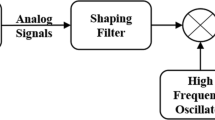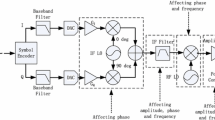Abstract
RF fingerprint (RFF) extraction is a fundamental issue of specific emitter identification (SEI). In most of current SEI techniques, the extracted RFFs are adversely affected by other components. This paper introduces a novel SEI system for the common communication signals. Empirical mode decomposition (EMD) method is applied in such system to separate components of a signal, which efficiently mitigates the obscurity problem of RFF. The principal component analysis (PCA) is then used to select the critical feature and a support vector machine (SVM) classifier is finally used to realize the emitter classification. In the experiments, the transient signals captured from four mobile phones and the steady signals from four WLAN cards are utilized to evaluate the performance. The experimental results highlight that the proposed method can achieve high accuracy of recognizing to transmitters.










Similar content being viewed by others
References
Scanlon, P., Kennedy, I. O., & Liu, Y. (2010). Feature extraction approaches to RF fingerprinting for device identification in femtocells. Bell Labs Technical Journal, 15(3), 141–151.
Gerdes, R. M., Daniels, T. E., & Mina, M. (2006). Device identification via analog signal fingerprinting: a matched filter approach. In NDSS.
Hall, J., Barbeau, M., & Kranakis, E. (2004). Enhancing intrusion detection in wireless networks using radiofrequency fingerprinting. In Proceedings of the 3rd IASTED international conference on communications, internet and information technology (CIIT) (pp. 201–206).
Yuan, Y., Huang, Z., & Sha, Z. (2013). Specific emitter identification based on transient energy trajectory. Progress In Electromagnetics Research C, 44, 67–82.
Kennedy, I. O., Scanlon, P., & Mullany, F. J. (2008). Radio transmitter fingerprinting: A steady state frequency domain approach. In IEEE 68th vehicular technology conference (VTC 2008-Fall) (pp. 1–5).
Hall, J., Barbeau, M., & Kranakis, E. (2006). Detecting rogue devices in bluetooth networks using radio frequency fingerprinting. In IASTED international conference on communications and computer networks.
Ellis, K. J., & Serinken, N. (2001). Characteristics of radio transmitter fingerprints. Radio Science, 36(4), 585–597.
Zhao, C., Huang, L., Hu, L. & Yao, Y. (2011). transient fingerprint feature extraction for WLAN cards based on polynomial fitting. In The 6th international conference on computer science and education (ICCSE 2011) (pp. 1099–1102).
Randall, W. K., Michael, A. T., & Michael, J. M. (2009). Application of wavelet-based RF fingerprinting to enhance wireless network security. Journal of Communications and Networks, 11(6), 544–555.
Yuan, Y., Huang, Z., & Wang, X. (2015). Detection of radio transient signal based on permutation entropy and GLRT. Wireless Personal Communications, 82(2), 1047–1057.
Yuan, Y., Huang, Z., Wu, H., & Wang, X. (2014). Specific emitter identification based on Hilbert–Huang transform-based time–frequency-energy distribution features. IET Communication, 8, 2404–2412.
Rehman, S. U., Sowerby, K., & Coghill, C. (2012). RF fingerprint extraction from the energy envelope of an instantaneous transient signal. In Australian communications theory workshop (pp. 90–95). New Zealand, Wellington.
Bertoncini, C., Rudd, K., & Nousain, B. (2012). Wavelet fingerprinting of radio-frequency identification (RFID) tags. IEEE Transactions on Industrial Electronics, 59(1), 34–41.
Padilla, P., Padilla, J. L., & Valenzuela-Valdes, J. F. (2013). Radiofrequency identification of wireless devices based on RF fingerprinting. Electronics Letters, 49, 1409–1410.
Huang, G., Yuan, Y., Wang, X., & Huang, Z. (2016). Specific emitter identification based on nonlinear dynamical characteristics. Canadian Journal of Electronics and Computer Engineering, 39(12), 4834–4850.
Afolabi, O., Kim, K., & Ahmad, A. (2002). Testing and troubleshooting digital RF communications transmitter designs. Agilent Technologies. Application note 1313, literature no. 5968-3578E.
Norden, E. H., Zheng, S., & Steven, R. L. (1998). The empirical mode decomposition and the Hilbert spectrum for nonlinear and non-stationary time series analysis. In Proceedings of the Royal Society of London, A (Vol. 454, pp. 903–995).
Shaw, D., & Kinsner, W. (1997). Multifractal modeling of radio transmitter transients for classification. In Proceedings of WESCANEX97 (pp. 306–312).
Ureten, O., & Serinken, N. (1999). Detection of radio transmitter turn-on transients. Electronics Letters, 35(23), 1996–1997.
Ureten, O., & Serinken, N. (2005). Bayesian detection of Wi-Fi transmitter RF fingerprints. Electronics Letters, 41(6), 373–374.
Hall, J., Barbeau, M., & Kranakis, E. (2003). Detection of transient in radio frequency fingerprinting using signal phase. In The 3rd IASTED international conference on wireless and optical communications (pp. 13–18).
Rasmussen, K. B., & Capkun, S. (2007). Implications of radio fingerprinting on the security of sensor networks. In Third international conference on security and privacy in communications networks and the workshops (pp. 331–340). IEEE.
Yuan, Y., Huang, Z., & Wang, X. (2014). Detection of frequency-hopping radio frequency-switch transients. Electronics Letters, 50(13), 956–957.
Serinken, N., & Ureten, O. (2000). Generalised dimension characterisation of radio transmitter turn-on transients. Electronics Letters, 36(12), 1064–1066.
Christopher, J. C., & Burges (1998). A tutorial on support vector machines for pattern recognition. Data Mining and Knowledge Discovery, 2, 121–167.
Lu, X., Yang, J., & Zhou, Y. (2010). A new method based on local integral bispectra and SVM for radio transmitter individual identification. In Information engineering (ICIE), 2010 WASE international conference on information engineering (pp. 65–68).
Billur, B., & Bahaeddin, E. (2012). Automatic radar antenna scan type recognition in electronic warfare. IEEE Transactions on Aerospace and Electronic Systems, 48(4), 2908–2931.
Afolabi, O., Kim, K., & Ahmad, A. (2009). On secure spectrum sensing in cognitive radio network using emitters electromagnetic signature. In Computer communications and networks, ICCCN 2009, proceeding of 18th international conference on IEEE (pp. 1–5).
Author information
Authors and Affiliations
Corresponding author
Rights and permissions
About this article
Cite this article
Liang, JH., Huang, ZT. & Li, ZW. Method of Empirical Mode Decomposition in Specific Emitter Identification. Wireless Pers Commun 96, 2447–2461 (2017). https://doi.org/10.1007/s11277-017-4306-0
Published:
Issue Date:
DOI: https://doi.org/10.1007/s11277-017-4306-0




